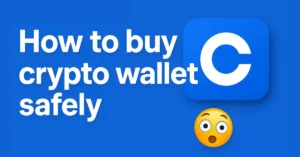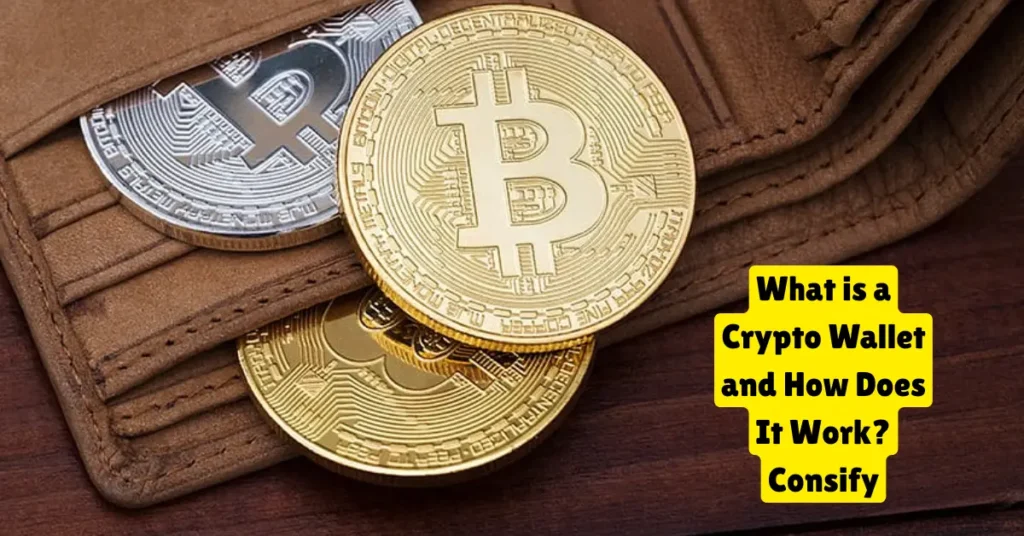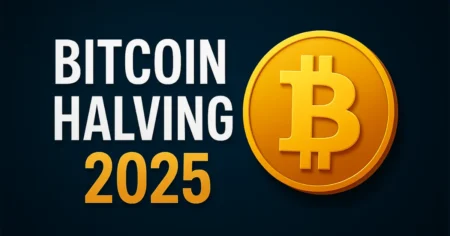Introduction
In recent years, cryptocurrencies like Bitcoin and Ethereum have become popular all over the world. People are not only investing in them but also using them for online payments, trading, and even saving for the future. But if you’re thinking about getting started with crypto, one of the first things you need to understand is how to store it safely and that’s where a crypto wallet comes in.
A crypto wallet helps you store and manage your digital coins securely. It works like a digital version of a regular wallet, but instead of holding cash, it holds something called “private keys” that give you access to your crypto.
At Coinsify, we believe everyone should have the knowledge and tools to use cryptocurrencies with confidence. That’s why in this post, we’ll explain what a crypto wallet is, how it works, and how you can choose the right one for your needs in simple and easy-to-understand language.
What is a Crypto Wallet and How Does It Work?

A crypto wallet is a digital tool that allows you to store, send, and receive cryptocurrencies like Bitcoin, Ethereum, and many others. But unlike a regular wallet that holds physical money, a crypto wallet doesn’t store your coins. Instead, it stores something even more important than your private keys.
These private keys are what prove that you own the cryptocurrency linked to your wallet. When you want to send crypto to someone, your wallet uses your private key to sign the transaction. When someone sends you crypto, your wallet helps you receive it using your public address which is like a bank account number that you can share with others.
Here’s a quick breakdown of how it works:
- Private Key: A secret code that allows you to access and control your crypto.
- Public Key: A code generated from your private key. It is used to create your wallet address.
- Wallet Address: The digital address where others can send you crypto. You can safely share this with anyone.
So, in simple terms, a crypto wallet lets you access your digital money, make transactions, and keep everything secure. Whether you’re using Coinsify or another platform, having a wallet is essential for anyone who wants to use or invest in cryptocurrencies.
Why Is a Crypto Wallet Important?
As more people start using cryptocurrencies for trading, investment, and payments, the need for safe and reliable storage becomes more important than ever. Just like you wouldn’t leave your cash lying around, you shouldn’t leave your crypto unprotected either. That’s where a crypto wallet plays a crucial role.

Here are the main reasons why having a crypto wallet is essential:
You Control Your Assets
- When you use a crypto wallet, especially a non-custodial one, you own your private keys.
- This means you have full control over your digital funds. No bank, company, or third party can freeze or access your crypto without your permission.
- This is one of the key ideas behind blockchain and cryptocurrency: financial freedom and ownership.
Safe and Secure Transactions
- A crypto wallet ensures that every transaction you make is encrypted and verified.
- You can send and receive crypto quickly without worrying about someone stealing your information.
- With good wallet practices like using strong passwords and saving your recovery phrase, your crypto can be kept very secure.
Protects You from Scams and Hacks
- Storing your crypto on exchanges can be risky. If the exchange gets hacked, you could lose everything.
- A personal wallet, especially a hardware wallet or a secure mobile wallet, lowers the risk of online attacks.
- Platforms like Coinsify often recommend using wallets for better security and peace of mind.
Gives You Access to DeFi and Web3 Services
- Many decentralized finance (DeFi) apps and Web3 platforms require a crypto wallet to connect and interact.
- If you want to earn through staking, lending, farming, or trading on decentralized platforms, you’ll need a wallet like MetaMask or Trust Wallet.
- Your wallet becomes your digital identity in the crypto world.
Supports Multiple Cryptocurrencies
- Good wallets allow you to store different coins and tokens in one place.
- Whether you hold Bitcoin, Ethereum, USDT, or any other altcoin, you can manage everything through one wallet interface.
- Wallets like those recommended on Coinsify offer multi-currency support with user-friendly features.
Backup and Recovery Options
- Crypto wallets offer backup options such as seed phrases (also called recovery phrases).
- If you lose your phone or device, you can still recover your wallet and crypto using the backup phrase.
- This ensures that your funds are never truly lost, as long as you keep your recovery information safe and private.
Useful for Everyday Payments
- Some wallets come with built-in features that allow instant payments for goods and services using crypto.
- They can generate QR codes for fast payments, convert crypto to fiat, or link with crypto debit cards.
- As more businesses accept crypto, wallets are becoming useful tools for everyday spending.
Helps You Stay Organized
- With a good wallet, you can track your portfolio, check real-time prices, and monitor past transactions.
- It helps you stay in control of your finances, especially if you’re trading or investing in multiple assets.
Final Thoughts
A crypto wallet is not just a storage tool it’s your gateway to the entire crypto ecosystem. It gives you control, security, and flexibility. Whether you’re a beginner or an experienced investor, having a good crypto wallet is one of the most important steps in your crypto journey.
Choosing the right wallet through trusted platforms like Coinsify can make all the difference. So before you buy or trade any cryptocurrency, make sure you understand your wallet options and how they work.
Step-by-Step Guide: What is a Crypto Wallet and How Does It Work?

Understanding how a crypto wallet works can feel confusing at first, especially if you’re new to digital currencies. But don’t worry, it’s easier than it sounds. This step-by-step guide will walk you through the basics of a crypto wallet, how it works behind the scenes, and how you can start using one safely.
Step 1: Understanding the Basic Concept
- Before you use a crypto wallet, it’s important to know what it does.
- A crypto wallet does not store your actual coins.
- It stores private and public keys, which are digital codes used to access and control your crypto.
- Your public key is like your account number; people can use it to send you money.
- Your private key is like your password; it must be kept secret at all times.
Step 2: Choosing the Right Type of Wallet
There are different types of wallets, each with its own features and security levels. The main types include:
- Hot Wallets (connected to the internet)
- Mobile wallets (e.g., Trust Wallet)
- Desktop wallets
- Web wallets (e.g., Coinsify-supported platforms)
- Easy to use, ideal for beginners
- Cold Wallets (offline storage)
- Hardware wallets (e.g., Ledger, Trezor)
- Paper wallets
Best for long-term holding and high-value storage
👉 Choose a wallet based on your needs: convenience or strong security.
Step 3: Downloading or Setting Up Your Wallet
Depending on your choice, the setup process may vary slightly:
- Mobile/Desktop Wallets: Download the app or software from an official source.
- Hardware Wallets: Buy a trusted device and follow the manufacturer’s setup instructions.
- Web Wallets: Sign up through a trusted platform like Coinsify or a crypto exchange.
During setup, you will be given a recovery phrase (also called a seed phrase). This is a series of words (usually 12 or 24) that act as a backup in case you lose access to your wallet.
⚠️ Important: Write down the recovery phrase and store it somewhere safe. Never share it with anyone.
Step 4: Receiving Crypto
Once your wallet is ready, you can start receiving cryptocurrency:
- Open your wallet and find your wallet address (a long string of letters and numbers).
- Share this wallet address with the person or platform sending you crypto.
- The transaction will appear in your wallet after it’s confirmed on the blockchain.
👉 Tip: Some wallets let you generate a QR code to make receiving crypto easier.
Step 5: Sending Crypto
To send crypto to someone else:
- Open your wallet and select the Send option.
- Enter the recipient’s wallet address and the amount you want to send.
- Double-check everything, especially the address transactions cannot be reversed.
- Confirm the transaction using your wallet’s authorization process (e.g., password, fingerprint, or device button).
- Your wallet uses your private key to sign the transaction and broadcast it to the blockchain for confirmation.
Step 6: Managing Your Wallet Securely
After setting up and using your wallet, follow these tips to keep your funds safe:
- Never share your private key or recovery phrase with anyone.
- Use strong passwords or biometric protection.
- Keep your wallet app and device up to date.
- Consider using a hardware wallet for large amounts.
Always download wallets and updates from trusted sources like Coinsify or official websites.
Step 7: Explore More Features
Modern crypto wallets offer more than just sending and receiving:
- Track your portfolio
- Swap between cryptocurrencies
- Connect with decentralized apps (DApps)
- Stake coins for passive income
- Buy crypto directly within the wallet (on supported platforms)
- These features can help you get more value and utility from your crypto holdings.
Final Thoughts
Now that you understand how a crypto wallet works and how to use it step by step, you’re ready to take full control of your digital assets. Whether you’re sending, receiving, or just holding coins, a wallet is a must-have tool for any crypto user.
Start with a trusted wallet solution and remember your security is in your hands. Platforms like Coinsify can help you choose the right wallet and guide you through your crypto journey safely and confidently.
Common FAQs About Crypto Wallets

What is a crypto wallet in simple words?
A crypto wallet is a digital tool that lets you store, send, and receive cryptocurrencies like Bitcoin or Ethereum. It doesn’t hold coins physically instead, it keeps your private keys safe, which are used to access your digital money.
Is a crypto wallet necessary to use cryptocurrency?
Yes. If you want to own, send, or receive cryptocurrency, you’ll need a crypto wallet. Some exchanges offer built-in wallets, but having your wallet gives you more control and security.
Are crypto wallets free to use?
Many crypto wallets are completely free to download and use, especially mobile and desktop ones. However, some hardware wallets (physical devices) need to be purchased.
What’s the difference between a hot wallet and a cold wallet?
Hot Wallet: Connected to the internet. Easy to access and use, but slightly more risky.
Cold Wallet: Offline storage. Much safer from hackers, great for long-term holding.
What is a private key, and why is it important?
A private key is a secret code that lets you access and control your crypto. If someone gets your private key, they can steal your coins. That’s why it should always be kept private and secure.
Can I recover my crypto if I lose my wallet?
Yes, if you have your recovery phrase (also called a seed phrase), you can restore your wallet and access your funds. If you lose the recovery phrase, there’s usually no way to get your crypto back.
Are crypto wallets safe?
Yes, most wallets are safe if you use them wisely. Always:
Use trusted wallet apps or hardware devices
Store your recovery phrase offline
Never share your private key
Can I use one wallet for different cryptocurrencies?
Yes, many wallets are multi-currency and support coins like Bitcoin, Ethereum, Binance Coin, and others in one place. Always check the wallet’s features before using it.
Is a wallet provided by Coinsify, or do I need to set one up separately?
Coinsify may offer wallet support or recommend trusted wallets you can use. You can also choose your wallet based on your preferences (like mobile, web, or hardware).
Can I have more than one crypto wallet?
Absolutely! You can have multiple wallets for different coins, purposes (e.g., trading vs. long-term holding), or just for extra security.
Is it safe to keep my crypto in an exchange wallet?
It’s okay for short-term use, but not recommended for long-term storage. If the exchange gets hacked or shuts down, you could lose your funds. That’s why having your wallet is much safer.
How do I choose the right wallet for me?
Ask yourself:
Do I need easy access or top-level security?
Will I use crypto daily or just hold it long-term?
Do I need support for many coins?
For beginners, a user-friendly mobile wallet is a good start. As you grow, you can upgrade to a hardware wallet for more security.
Conclusion
A crypto wallet is one of the most important tools for anyone using or investing in cryptocurrency. It helps you store, send, and receive digital coins safely. Whether you’re just starting out or already exploring platforms like Coinsify, having the right wallet gives you more control, better security, and peace of mind. Choose a wallet that fits your needs, keep your private keys safe, and you’re ready to start your crypto journey with confidence.
Bonus Tips for Using a Crypto Wallet Safely and Smartly

Always Double-Check Wallet Addresses
- Before sending crypto, always double-check the receiver’s address. Crypto transactions are permanent and cannot be reversed. One small mistake can lead to a loss of funds.
Use Two-Factor Authentication (2FA)
- If your wallet or exchange offers 2FA, enable it. It adds an extra layer of protection, especially against unauthorized logins or transfers.
Keep Your Recovery Phrase Offline
- Never store your recovery/seed phrase online or in cloud storage. Write it down on paper and keep it somewhere safe, like a locked drawer or fireproof safe.
Update Wallet Apps Regularly
- Keep your wallet app or software up to date. Developers release updates to fix bugs and improve security.
Use a Separate Wallet for Large Amounts
- For everyday use, a mobile or web wallet is fine. But for larger holdings, consider using a cold (hardware) wallet to keep your funds extra secure.
Learn Before You Click
- Many scams look very real fake wallet apps, phishing emails, or links. Always research and verify before downloading or clicking anything.
Use a Trusted Platform like Coinsify






